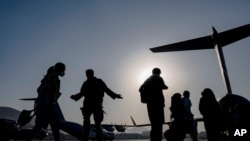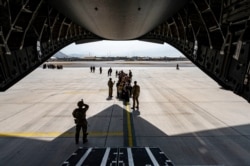The final American evacuation flights from Afghanistan—likely Tuesday—will be the most perilous. They will carry the last detachments of rearguard U.S. troops out of the country and will have no friendly ground force to protect them, Western military officials say.
They will have to depend on Taliban fighters to ensure no rocket or mortar attack is launched by Islamic State Khorasan, or ISIS-K, on the airport as the rearguard draws down—or as the planes take off from the airport, say American and British officials. The final flight will be highly risky, they admit.
General Nick Carter, chief of Britain’s Defense Staff, said Saturday everyone should be aware of the daunting test U.S. commanders and soldiers will face in trying to ensure the final planes leave Afghanistan safely. “We should be holding our breath and thinking of that last plane and what a challenge it's going to be for those brave people,” he told Britain’s Sky News.
Britain will have ended its evacuation operations Saturday, but the final British aircraft will be departing under the watchful eye of U.S. ground forces. Thirteen U.S. servicemen and at least 170 Afghan civilians were killed after an Islamic State suicide bombing Thursday near the airport, prompting many western countries to scramble to complete their final evacuation flights from Afghanistan. The Pentagon said at least 18 troops were injured in the attack.
Many of the Afghan civilians killed were left piled in a sewage ditch, and at least 200 were wounded, according to Taliban officials.
ISIS-K claimed responsibility on its Amaq news agency for the attack, and the first American combat fatalities in Afghanistan since February 2020.
General Kenneth McKenzie, head of the Pentagon’s central command, says he expects ISIS-K to try to strike again. “We believe it is their desire to continue those attacks … and we’re doing everything we can to be prepared,” he told reporters in Washington.
On Friday, the U.S. conducted a drone strike targeting an IS planner, U.S. Central Command said in a statement. “U.S. military forces conducted an over-the-horizon counterterrorism operation today [Friday] against an ISIS-K planner. The unmanned airstrike occurred in the Nangarhar Province of Afghanistan,” spokesman Capt. Bill Urban said.
“Initial indications are that we killed the target. We know of no civilian casualties,” Urban added. The announcement of the strike came a day after U.S. President Joe Biden vowed to retaliate for the attack on Kabul airport.
At a press briefing Friday, White House press secretary Jen Psaki told reporters the White House national security team had advised Biden “another terror attack at Kabul airport is likely.”
“The threat is ongoing, and it is active. Our troops are still in danger,” she continued before adding, “this is the most dangerous part of the mission.”
More than 5,000 U.S. service members are still deployed at Kabul airport and will be slowly drawn down over the next few days. That’s a larger number than remained deployed in the final days of the American military evacuation from Saigon, Vietnam in 1975, when all but 1,250 Americans—few enough to be removed in a single day's helicopter airlift—were left to guard the airport.The Pentagon had to alter at the last minute its final evacuation plans from Vietnam, which had called for fixed-wing aircraft to be used. But because of rocket fire and debris on the runways at the airport at Tan Son Nhut air base, the final withdrawal was conducted by helicopters able to fly to U.S. warships in the South China Sea.
As Pentagon strategists and commanders on the ground run through their plans and try to refine them for the final day of U.S. flights from Kabul airport, officials say discussions are being held with Taliban leaders about security. They say they’re hopeful the Taliban and the U.S. have a shared interest in ensuring the final flights go off without mishap.
American military officials have asked for the Taliban to block more roads and to widen the security perimeter around the airport. But as the last planes are readying for departure, there will be no trained Western security observers around to ensure there is nothing approaching the aircraft and that no suicide bomber gets close.
“There will be no security-in-depth,” a Pentagon official told VOA on the condition of anonymity. He added that patrolling armed drones will try to provide as much protection as possible.
At some point, U.S. ground forces likely will be replaced by Taliban fighters in parts of the airport as U.S. troops withdraw, U.S. officials told VOA. It is unclear, though, whether that will happen as part of an orchestrated handover that’s being negotiated with commanders of the militant Islamic group.
Pentagon spokesman John Kirby denied reports Friday the Taliban had taken over some security duties at the airport. “I saw that report, too,” Kirby said. “It’s false. They’re not in charge of any of the gates. They are not in charge of any of the airport operations. That is still under U.S. military control,” he said in Washington.
Since Thursday, Taliban and IS fighters have clashed several times in west Kabul, according to local media reports. Several hundred Islamic State fighters are estimated to have been freed when the Taliban took control of Kabul and other major cities, including Kandahar, and opened prison gates.







